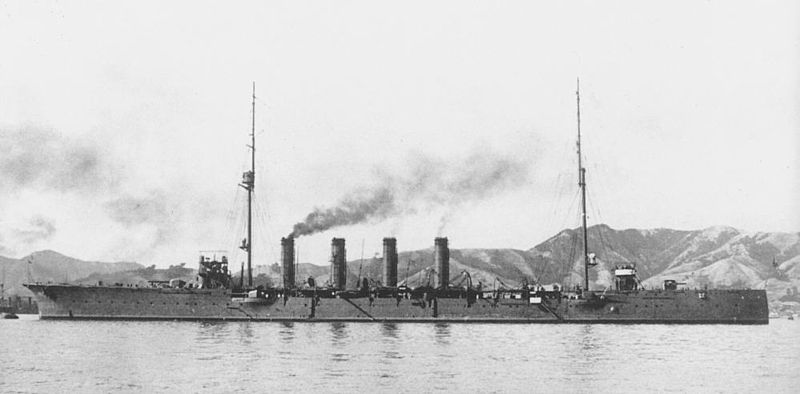
The Japanese turbine Cruisers: The three cruisers described here are in the straight line of the early prewar turbine cruisers, very fast and often recoignised to their numerous funnels. They are to be compared to the Admiral Spaun, Nino Bixio, Magdeburg, Chester, C-class and “Town” classes. Chikuma participated in various operations in World War I in the central and southern Pacific Ocean, was sank as target in 1935 but Yahagi was used in the the Siberian Intervention and the opening stages of the Second Sino-Japanese War and stricken on 1 April 1940 exactly as Hirado also stricken on 1 April 1940. However Hirado’s hulk was still serving as a barracks until 1943 whereas IJN Yahagi served for five more years as a training vessel at the Japanese Naval Academy at Eta Jima.
Conception of the Chikuma class cruisers
The Chikuma class cruisers were based on the sole Tone, a protected cruiser ordered as part of the 1907 Naval Expansion Program. The new Chikuma class was to be much larger three ships were built, the Chikuma, the Yahagi, and the Hirado, at Sasebo, Mitsubishi and Kawasaki, all completed by 1912. They were quite unique for the time for their monocaliber battery, an idea inspired by the Dreadnought but not adopted elsewhere until the British Dartmouth class. In addition to the main armament, two more 3-in guns (78 mm), were also added to the two existing, plus torpedo tubes.
The great novelty was in their powerplant, as all three ships were equipped with turbines, which differed according to their yard: Yahagi had a Parsons turbine, and the two others, Curtis models. They were successful and all served for long quite long, even seeing the start of WW2 for Yahagi and the Hirado.
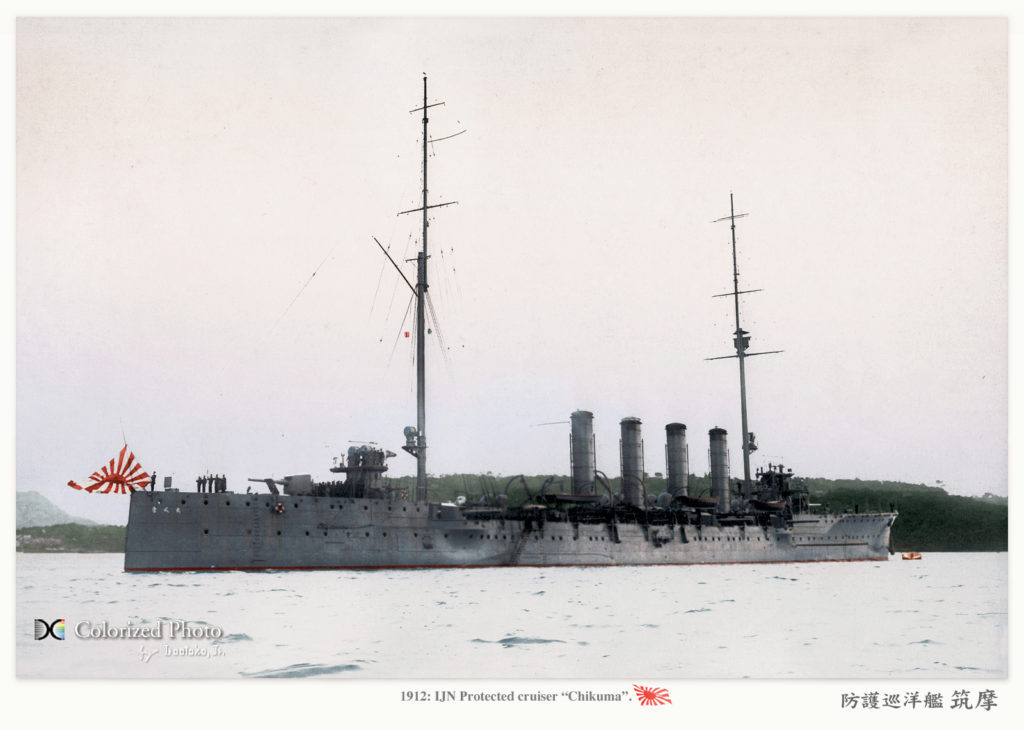
Colorized photo of the Chikuma by Hirootoko Jr.
Design of the Chikuma class cruisers
Protection
The basic design of the Chikuma-class cruisers followed the latest Royal Navy Town class, but also integrated advances already present with the cruiser Tone. The Chikuma’s class appearance was evident with its four smokestacks, quite unique in Japanese design (outside the later Sendai class). There has ben confusion among authors about the level of protection of the Chikuma class, which was similar to the Tone class. Although assimilated as a light cruiser, this was a protected cruiser without a proper armoured belt. Armour protection consisted of a protective deck ranging from 22 mm (0.87 in) beyond the central section (magazines and machinery), froward and aft, up to 57 mm (2.2 in) over the machinery space and magazines. The only other protected part was the Conning tower, 102 mm (4.0 in) strong.
Propulsion
The Chikuma-class were the first Japanese cruisers fitted with turbines in the Imperial Japanese Navy. This solution inspired by the dreadnought helped achieving greater speeds, notably that of the IJN Tone, which was given triple expansion steam engine. The 4100 tonnes Tone had 16 Miyabara boilers for 15,000 hp and 23 knots, whereas the the Chikuma class were able to reach three more knots.
Chikuma and Hirado both had Curtiss turbines, two shaft steam turbine engines and 16 Kampon boilers for a total of 22,500 hp (16,800 kW) versus 15,000 hp on the Tone.
This allowed these cruisees to reach a top speed of 26 knots (48 km/h; 30 mph), and in speed trials, this was confirmed by reaching 26.83 and 26.87 knots. IJN Yahagi had a Parsons-type turbine engine, achieving 27.14 knots during speed trials. If the its target of high speed was reached, this new technology provoked teething issues in early service, notably with material strength and fatigue, and maintenance issues.
Armament
The Chikuma armament was quite unique by its single caliber main battery, eight Type 41 6 inch, 45 caliber naval guns. Two were placed fore and aft, and three in sponsons, on either side of the hull. In addition these ships received four Quick Firing 12-pounder, 12 cwt naval guns and two Lewis guns. The 6-in originated from Armstrong Elswick, and had separate loading bagged charge 22 kg (49 lb), with a shell weighting 45.4 kg (100 lb). They had a breech interrupted screw and could elevate -5° to +18° and traverse -150° to +150°, with a rate of fire of 5 rpm and a muzzle velocity of 825 m/s (2,710 ft/s), and maximum firing range of 14.8 km (9.2 mi) at 18°.
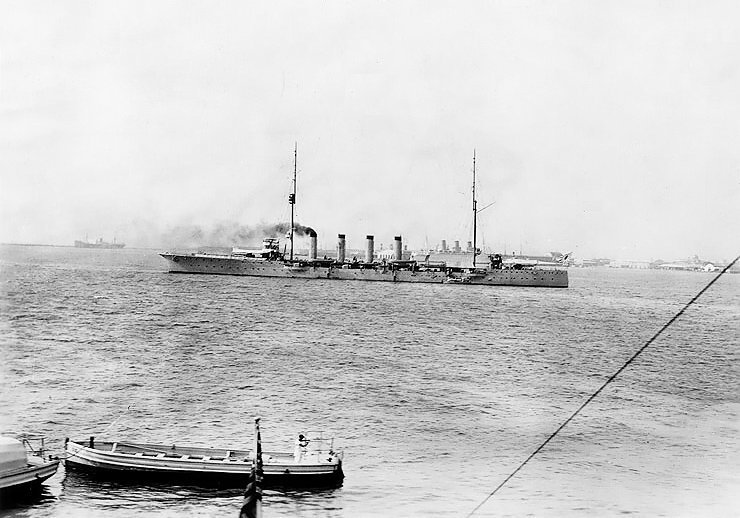
The 12-pounder, 12 cwt guns dated back from a British Elswick design of 1894, modernized since and produced locally by Japan Steel Works. The qualification 12 cwt (for “hundredweight”). This was related to the weight of the barrel and breech. The 12-Pdr also referred locally as Type 41 3-inch (76.2 mm)/40 weighted (0.6 tons, 510 kg), with an overall length of 10 ft 3 in (3.12 m), and barrel length alone of 10 ft (3 m). It was breech-loaded, capable of 15 rounds per minute, with a muzzle velocity of 2,210 ft/s (670 m/s), and effective firing range of 11,750 yd (10,740 m) at 40° elevation.
In addition, there cruisers were given with three torpedo launchers fitted with 457 mm (18 in) torpedoes and after 1919, due to the growing AA threat, two 8 cm/40 3rd Year Type naval gun were added, on anti-aircraft mounts. They were placed abaft the fourth funnel, in place of the former replacing two 12-pounders (in Hirado), or three for the Yahagi and Chikuma.
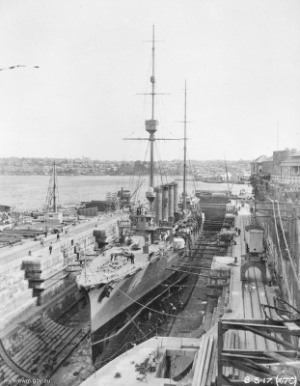
IJN Hirado in drydock Sydney in 1917 (Australian War Museum)
The Chikuma class in action
IJN Chikuma
IJN Chikuma was active in WWI, and contributed to the Allied war effort under the Anglo-Japanese Alliance. She was part of the Japanese squadron giving chase to the German East Asia Squadron (Admiral Von Spee) from August 1914. The Ibuki, Chikuma and Nisshin chased the ellusive squadron in the Indian Ocean as this was a real threat for shipping, especially the German cruiser Emden thrown into a diversionary action.
From December 1914 to January 1915, Chikuma and Yahagi patrolled off the coast of northern Queensland in Australia. From 26 March 1917, the British Admiralty pressed the deployment of the Chikuma and Hirado to Australia and New Zealand. They were assigned to the protection of shipping against possible German commerce raiders.
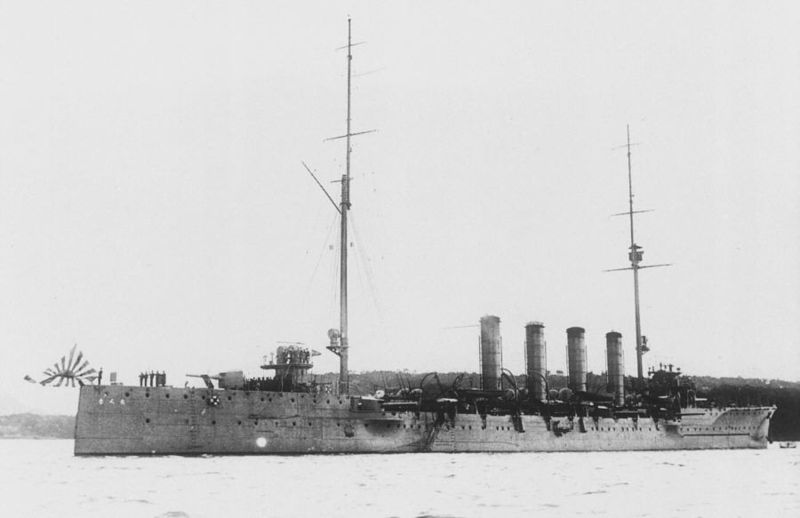
After the war, IJN Chikuma was patrols off China in 1921-1924 and afterwards she was seen already as obsolete and her combat use was to be reduced. She was assigned as a moored training ship at Yokosuka Naval District, after being moved to the reserves. IJN Chikuma was stricken from the list on 1 April 1931 but her hulk survived was as the Hai Kan No.3 target. She was sunk in that guide in 1935.
IJN Yahagi
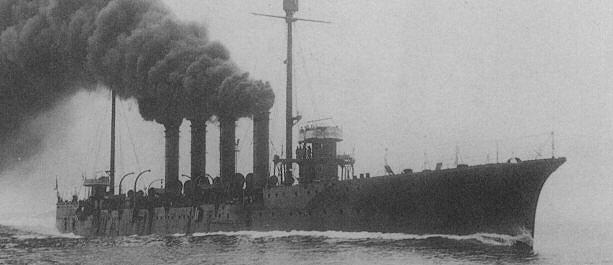
IJN Yahagi fought in WWI under the Anglo-Japanese Alliance, like her sister-ship, she was deployed against the German East Asia Squadron. Hirado and Yahagi teamed up within the 2nd Southern Squadron (admiral ship IJN Satsuma, Rear-Admiral Matsumura Tatsuo). The squadron patrolled the region around Sumatra, searching for the German cruiser Emden. From December 1914 to January 1915, the two cruisers also patrolled off the coast of northern Queensland, Australia, always in search of possible raiders that can threatens merchant traffic.
By 7 February 1917, this IJN squadron was reformed as the First Special Squadron with the cruisers Yahagi, Tsushima, Suma and Niitaka. They also integrated the Second Destroyer Flotilla. The composite squadron was based at Singapore under Rear Admiral Kozaburo Oguri. By 26 March 1917, the British Admiralty asked to deploy them to Australia and New Zealand, in order to continue the protection of shipping against German raiders.
Yahagi and Suma were also deployed in the Indian Ocean in close cooperation with the British China Squadron. Yahagi patrolled the eastern coasts of Australia and New Zealand until October 1917 and was the last ship deployed to defend Australia and New Zealand. She only went back to Japan, on 21 October 1918. Its crew however was struck with influenza in December 1918. She was in quarantine at Manila harbor, ad during her 46 days of immobilization, 300 of her crew were ill while 48 died.
Yahagi in 1919 patrolled off the coast of eastern Russia, provided protection and support for the supply convoys to Siberia during the Japanese Siberian Intervention against the Bolsheviks. She was then posted to protect Japanese southern approaches. She alternated between Manila and Macau. From 1923 and until 1937 IJN Yahagi patrolled the China sea, later replacing the Tone as station ship on the Yangtze River.
With the war breaking in 1937, she was placed in reserve as a training ship at anchor. She would be stricken from the list on 1 April 1940. Her new affectation was as a target ship named Hai Kan No.12, posted at the Etajima Imperial Japanese Naval Academy. She became a barracks ship for submarine crews until 1943 and was scrapped on 8 July 1947.
IJN Hirado
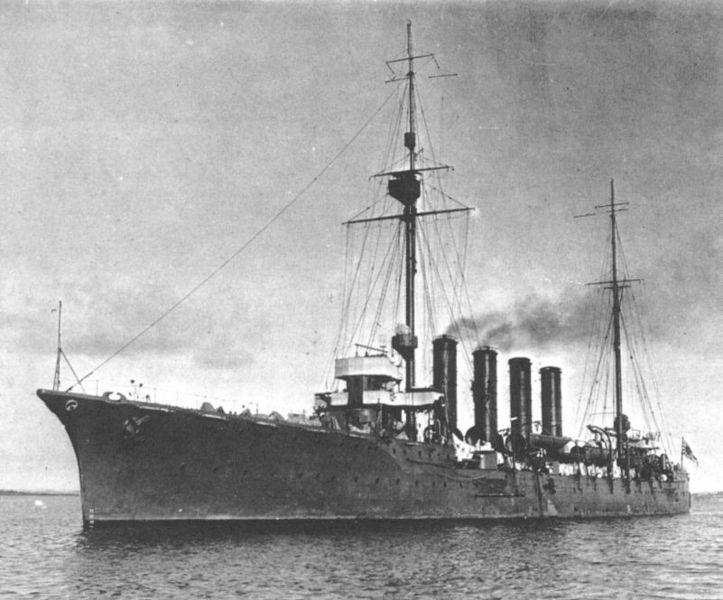
Hirado in WWI, was active under the same Anglo-Japanese Alliance and deployed with the Japanese squadron against the German East Asia Squadron. IJN Hirado and Yahagi were part of the Allied 2nd Southern Squadron (Rear-Admiral Matsumura Tatsuo) patrolling around Sumatra, trying to catch the SMS Emden. From 26 March 1917 she was deployed with Chikuma and Hirado to Australia and New Zealand, and later in the war, she was supporting the Japanese expedition against the Red Army off the east coast of Russia. The goal was to prevent any raids on supply convoys, in support of ground forces in Siberia. Admiral Osami Nagano took command of IJN Hirado in 1919-1920, followed by Captain Zengo Yoshida until December 1924.
Hirado was deployed in protection of the southern approaches to Japan, stationed at Manila and Macau. In 1932, she was affected to the northern Chinese coast after the Manchurian Incident. She was based at Ryojun Guard District (Kwantung Territory). Engines problems however had her frequently stationed in repair yards. She was unable however to take part in combat operations during the 1937 Sino-Japanese War.
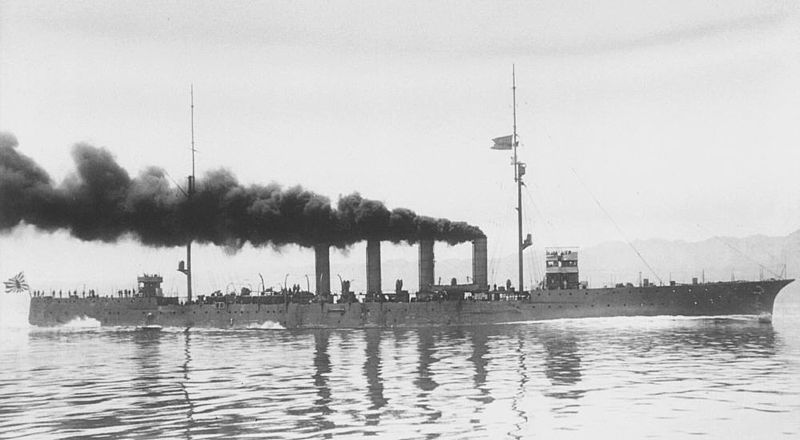
Inded, placed indeed in reserve by 1933 she became a training ship until she was stricken from the navy list on 1 April 1940. She became afterwards IJN Hai Kan No.11, and was moored as a barracks ship at Etajima. She was later towed to Kure, and Iwasaki in December 1943. She was scrapped after the war, starting in April 1947. Part of the hull filled a section of the Iwakuni port breakwater.
Specifications of the Chikuma class |
|
| Displacement: 5,040 long tons (5,100 t) standard | |
| Dimensions: 144.8 m (475 ft 1 in), Beam 14.2 m (46 ft 7 in), Draught 5.1 m (16 ft 9 in) | |
| Propulsion: 2 shafts steam turbine, 16 Kampon boilers; 22,500 hp, 26 knots (30 mph; 48 km/h) radius 10,000 nmi (19,000 km) at 10 kn (12 mph; 19 km/h) | |
| Deck: 22-57 mm, CT 102 mm (4.0 in) | |
| Crew: 400 | |
| Armament: 8 × 6 in/45, 4 × 12 pdr, 2 × 7.7 mm, 3 × 457 mm TTs | |
Sources/read more
https://www.globalsecurity.org/military/world/japan/chikuma-cl.htm
en.wikipedia.org/wiki/Chikuma-class_cruiser
Conway’s all the world’s battleships 1860-1905 & 1906-1921
http://www.navweaps.com/Weapons/WNJAP_6-45_EOC.php
Nishida, Ships of the Imperial Japanese Navy
Jentsura, Warships of the Imperial Japanese Navy; page 104-105
Evans, David C.; Peattie, Mark R. (1997). Kaigun: Strategy, Tactics, and Technology in the Imperial Japanese Navy, 1887-1941.
Howarth, Stephen (1983). The Fighting Ships of the Rising Sun: The Drama of the Imperial Japanese Navy, 1895-1945.
Jentsura, Hansgeorg (1976). Warships of the Imperial Japanese Navy, 1869-1945.
Schencking, J. Charles (2005). Making Waves: Politics, Propaganda, And The Emergence Of The Imperial Japanese Navy, 1868-1922.
Tucker, Spencer C (2005). Encyclopedia Of World War I: A Political, Social, And Military History.

Illustration of the Chikuma by the Author (1/750)


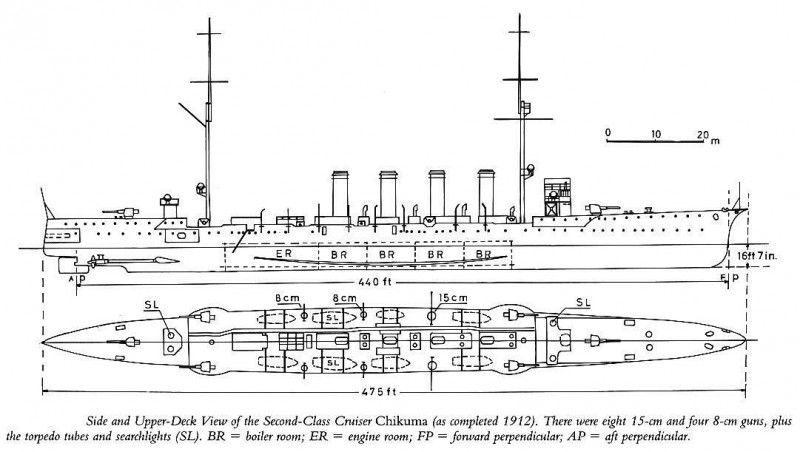
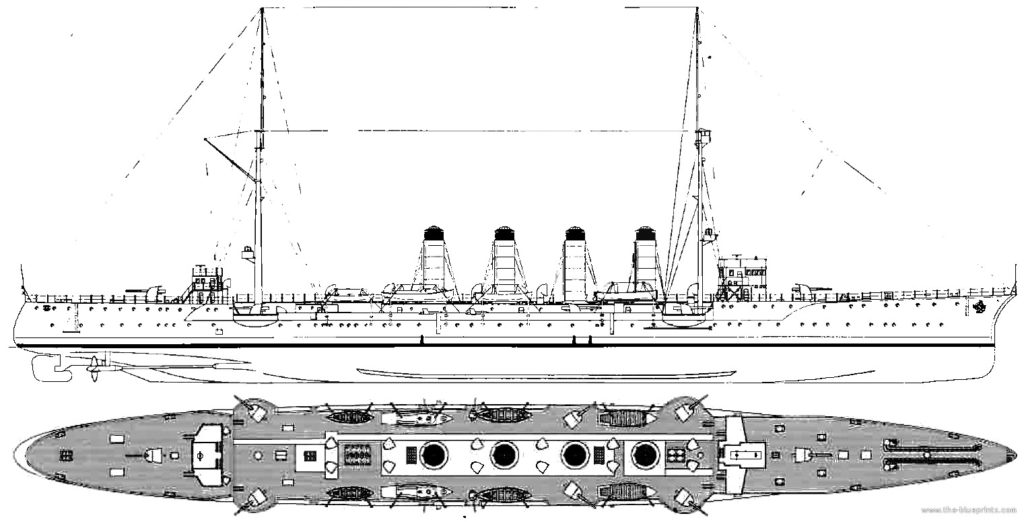
 Latest Facebook Entry -
Latest Facebook Entry -  X(Tweeter) Naval Encyclopedia's deck archive
X(Tweeter) Naval Encyclopedia's deck archive Instagram (@navalencyc)
Instagram (@navalencyc)





 French Navy
French Navy Royal Navy
Royal Navy Russian Navy
Russian Navy Armada Espanola
Armada Espanola Austrian Navy
Austrian Navy K.u.K. Kriegsmarine
K.u.K. Kriegsmarine Dansk Marine
Dansk Marine Nautiko Hellenon
Nautiko Hellenon Koninklije Marine 1870
Koninklije Marine 1870 Marinha do Brasil
Marinha do Brasil Osmanlı Donanması
Osmanlı Donanması Marina Do Peru
Marina Do Peru Marinha do Portugal
Marinha do Portugal Regia Marina 1870
Regia Marina 1870 Nihhon Kaigun 1870
Nihhon Kaigun 1870 Preußische Marine 1870
Preußische Marine 1870 Russkiy Flot 1870
Russkiy Flot 1870 Svenska marinen
Svenska marinen Søværnet
Søværnet Union Navy
Union Navy Confederate Navy
Confederate Navy Armada de Argentina
Armada de Argentina Imperial Chinese Navy
Imperial Chinese Navy Marinha do Portugal
Marinha do Portugal Mexico
Mexico Kaiserliche Marine
Kaiserliche Marine 1898 US Navy
1898 US Navy Sovietskiy Flot
Sovietskiy Flot Royal Canadian Navy
Royal Canadian Navy Royal Australian Navy
Royal Australian Navy RNZN Fleet
RNZN Fleet Chinese Navy 1937
Chinese Navy 1937 Kriegsmarine
Kriegsmarine Chilean Navy
Chilean Navy Danish Navy
Danish Navy Finnish Navy
Finnish Navy Hellenic Navy
Hellenic Navy Polish Navy
Polish Navy Romanian Navy
Romanian Navy Turkish Navy
Turkish Navy Royal Yugoslav Navy
Royal Yugoslav Navy Royal Thai Navy
Royal Thai Navy Minor Navies
Minor Navies Albania
Albania Austria
Austria Belgium
Belgium Columbia
Columbia Costa Rica
Costa Rica Cuba
Cuba Czechoslovakia
Czechoslovakia Dominican Republic
Dominican Republic Haiti
Haiti Hungary
Hungary Honduras
Honduras Estonia
Estonia Iceland
Iceland Eire
Eire Equador
Equador Iran
Iran Iraq
Iraq Latvia
Latvia Liberia
Liberia Lithuania
Lithuania Mandchukuo
Mandchukuo Morocco
Morocco Nicaragua
Nicaragua Persia
Persia San Salvador
San Salvador Sarawak
Sarawak Uruguay
Uruguay Venezuela
Venezuela Zanzibar
Zanzibar Warsaw Pact Navies
Warsaw Pact Navies Bulgaria
Bulgaria Hungary
Hungary

 Bundesmarine
Bundesmarine Dutch Navy
Dutch Navy Hellenic Navy
Hellenic Navy Marina Militare
Marina Militare Yugoslav Navy
Yugoslav Navy Chinese Navy
Chinese Navy Indian Navy
Indian Navy Indonesian Navy
Indonesian Navy JMSDF
JMSDF North Korean Navy
North Korean Navy Pakistani Navy
Pakistani Navy Philippines Navy
Philippines Navy ROKN
ROKN Rep. of Singapore Navy
Rep. of Singapore Navy Taiwanese Navy
Taiwanese Navy IDF Navy
IDF Navy Saudi Navy
Saudi Navy Royal New Zealand Navy
Royal New Zealand Navy Egyptian Navy
Egyptian Navy South African Navy
South African Navy






























 Ukrainian Navy
Ukrainian Navy dbodesign
dbodesign